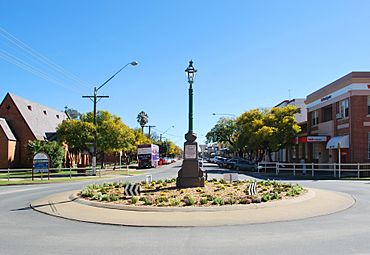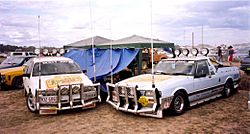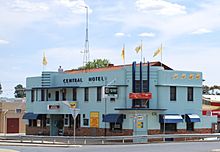Deniliquin facts for kids
Quick facts for kids DeniliquinNew South Wales |
|||||||||
|---|---|---|---|---|---|---|---|---|---|

Deniliquin town centre
|
|||||||||
| Population | 7,862 (2016 census) | ||||||||
| Postcode(s) | 2710 | ||||||||
| Elevation | 93.0 m (305 ft) | ||||||||
| Location | |||||||||
| LGA(s) | Edward River Council | ||||||||
| County | Townsend | ||||||||
| State electorate(s) | Murray | ||||||||
| Federal Division(s) | Farrer | ||||||||
|
|||||||||
Deniliquin, known locally as "Deni", is a town in the Riverina region of New South Wales, Australia, close to the border with Victoria. It is the largest town in the Edward River Council local government area.
Deniliquin is located at the intersection of the Riverina and Cobb Highway approximately 725 kilometres (450 mi) south west of the state capital, Sydney and 285 kilometres (177 mi) due north of Melbourne. The town is divided in two parts by the Edward River, an anabranch of the Murray River, with the main business district located on the south bank.
The town services a productive agricultural district with prominent rice, wool and timber industries. At the 2016 census, the urban population of Deniliquin was 6,833.
Contents
History
Prior to European settlement, the Aboriginal inhabitants of the Deniliquin area were the Barapa Baraba people.
In 1843 the entrepreneur and speculator Benjamin Boyd acquired land in the vicinity of present-day Deniliquin (probably via his agent Augustus Morris). The location was known as The Sandhills, but Boyd (or Morris) named it Deniliquin after 'Denilakoon', a local Aboriginal Australian famed for his wrestling prowess. An inn and a punt were established on the site in the period 1845-47 and the town site was surveyed in 1848 and gazetted in 1850. Deniliquin Post Office opened on 1 January 1850.
In 1853, William John Wills of the Burke and Wills expedition worked as a shepherd at the Royal Bank sheep station near Deniliquin.
As Deniliquin was established on the convergence of major stock routes between the colonies of Queensland, New South Wales and the Victorian gold rush centres of Victoria, it soon became an important river crossing and the first bridge was built over the Edward River in 1861. The Deniliquin and Moama Railway Company built a private railway in 1879 to connect with Moama, across the Murray River from the busy river port of Echuca, connected by rail to Melbourne.
Wool growing quickly became a major industry and the area around Deniliquin was home to several Merino studs. In 1861, George Hall Peppin and his two sons, experienced English sheep breeders, established a Merino stud at Wanganella station, north of Deniliquin. There, the brothers developed the Peppin Merino, able to thrive in drier inland regions. Today, as many as 70 per cent of Merinos in Australia are said to be directly descended from these sheep.
In the 1860s, Deniliquin was the centre of a short-lived campaign by wealthy pastoralists including Peppin, George Desailly, Robert Landale and William Brodribb for secession from New South Wales and the creation of a new Riverina colony. This campaign was supported by David Jones, the proprietor of the local newspaper the Pastoral Times.
On 19 December 1868, Deniliquin was constituted as The Municipality of Deniliquin, and the first Municipal Election was held on 23 February 1869. In 1993 the enactment of the Local Government Act (NSW) saw the name of the council changed from the Municipality of Deniliquin to the Deniliquin Council.
Large-scale irrigation schemes came to the Deniliquin area with the establishment of the Deniboota and Denimein Irrigation Districts in 1938 and the Berriquin Irrigation District in 1939, using water diverted from the Murray River at Lake Mulwala through the Mulwala Canal. An ample and reliable water supply led to the development of water intensive industries such as rice growing.
During the Second World War, RAAF Station Deniliquin was home to No. 7 Service Flying Training School RAAF. It was also a final disbanding site for squadrons returning from active duty against the Japanese in the Pacific. No. 22 Squadron RAAF and No. 30 Squadron RAAF were disbanded here in 1946, and in 1945 and 1946 it was also a base for No. 78 Squadron RAAF before it was finally disbanded in Williamtown.
Also World War 2, Muswellbrook was the location of RAAF No.15 Inland Aircraft Fuel Depot (IAFD), completed in 1942 and closed on 29 August 1944. Usually consisting of 4 tanks, 31 fuel depots were built across Australia for the storage and supply of aircraft fuel for the RAAF and the US Army Air Forces at a total cost of £900,000 ($1,800,000).
In April 2006 the Herald Sun reported on their front cover that the Edward River was dry, with an accompanying photograph showing a dry creek. This was later revealed to be erroneous; the photograph was of an unknown channel on a farm within 60 kilometres (37 mi) of Deniliquin, while the Edward River is in fact still running. Deniliquin Council and members of the Deniliquin community have since attempted to rectify the damage to local tourism by improving the profile of Deniliquin in various media outlets.
Climate
Deniliquin has a semi-arid climate with dry summers and mild winters. The town's highest temperature of 49.5 °C (121 °F) was reached on 12 January 1878 and is one of the highest ever recorded in Australia.
| Climate data for Deniliquin | |||||||||||||
|---|---|---|---|---|---|---|---|---|---|---|---|---|---|
| Month | Jan | Feb | Mar | Apr | May | Jun | Jul | Aug | Sep | Oct | Nov | Dec | Year |
| Record high °C (°F) | 49.5 (121.1) |
47.2 (117.0) |
45.0 (113.0) |
41.7 (107.1) |
31.1 (88.0) |
25.6 (78.1) |
25.9 (78.6) |
29.8 (85.6) |
35.0 (95.0) |
40.8 (105.4) |
44.2 (111.6) |
47.8 (118.0) |
49.5 (121.1) |
| Average high °C (°F) | 32.5 (90.5) |
32.0 (89.6) |
28.7 (83.7) |
23.5 (74.3) |
18.6 (65.5) |
15.1 (59.2) |
14.4 (57.9) |
16.4 (61.5) |
19.7 (67.5) |
23.6 (74.5) |
27.5 (81.5) |
30.6 (87.1) |
23.6 (74.5) |
| Average low °C (°F) | 15.7 (60.3) |
15.7 (60.3) |
13.3 (55.9) |
9.5 (49.1) |
6.5 (43.7) |
4.5 (40.1) |
3.4 (38.1) |
4.4 (39.9) |
6.2 (43.2) |
8.8 (47.8) |
11.7 (53.1) |
14.1 (57.4) |
9.5 (49.1) |
| Record low °C (°F) | 4.4 (39.9) |
4.5 (40.1) |
0.6 (33.1) |
0.0 (32.0) |
−3.9 (25.0) |
−5.6 (21.9) |
−6.1 (21.0) |
−6.1 (21.0) |
−3.3 (26.1) |
−1.7 (28.9) |
0.6 (33.1) |
2.2 (36.0) |
−6.1 (21.0) |
| Average precipitation mm (inches) | 28.2 (1.11) |
28.2 (1.11) |
32.1 (1.26) |
30.2 (1.19) |
38.0 (1.50) |
39.8 (1.57) |
34.9 (1.37) |
36.7 (1.44) |
37.7 (1.48) |
39.3 (1.55) |
29.9 (1.18) |
29.7 (1.17) |
404.8 (15.94) |
| Average precipitation days | 3.8 | 3.6 | 4.1 | 5.1 | 7.4 | 9.1 | 9.6 | 9.5 | 8.4 | 7.4 | 5.3 | 4.6 | 77.9 |
| Average relative humidity (%) | 30 | 33 | 37 | 44 | 56 | 63 | 62 | 55 | 48 | 40 | 34 | 31 | 44 |
Deni Play on the Plains Festival
Deniliquin is home to the Play on the Plains Festival held each September/October on the New South Wales Labour Day long weekend. The festival includes the famous 'Deniliquin Ute Muster'
The Deni Play On The Plains Festival has set the following world records:
- World Record Ute Count
- 1999 - 2839 utes in one location
- 2000 - 2990 utes in one location
- 2001 - 3012 utes in one location
- 2002 - 3070 utes in one location
- 2003 - 3418 utes in one location
- 2004 - 4012 utes in one location
- 2005 - 6172 utes in one location
- 2006 - 6211 utes in one location
- 2007 - 6235 utes in one location
- 2008 - 7242 utes in one location
- 2009 - 7000 utes in one location
- 2010 - 10,152 utes in one location
- World Record Blue Singlet Count
- 2004 - 1328 people wearing blue singlets
- 2005 - 1474 people wearing blue singlets
- 2006 - 1566 people wearing blue singlets
- 2007 - 1587 people wearing blue singlets
- 2008 - 2702 people wearing blue singlets
- 2009 - 2230 people wearing blue singlets
- 2010 - 3500 people wearing blue singlets
Music
Deniliquin has had many local bands, some notable one's being the Lincolns, Mannik, the Stormtroopers and the Lexies. Attempts been made to encourage other bands to come to Deniliquin to perform, with varying success. Solo performers who came from Deniliquin include Shane McGrath, Michael Gorham and Joel Sulman, with local artists often showcased at the Deniliquin Ute Muster.
Music festivals
Deniliquin has been home to many music festivals. These include:
- Deniliquin Blues and Roots Festival
Held over the Easter long weekend and has bought acts such as Status Quo, Santana, Jason Mraz (2013) and will hold in 2014 John Mayer, Elvis Costello, local artist Michael Gorham and previous local blues artist Joel Sulman. It won Best Inland Festival for 2013 and continues to grow as the time gets closer to launch!
- The Flat Earth Festival, organised by a youth committee under the auspices of South West Music, beginning in 1999 and running until 2003. The aim of the Flat Earth Festival (so named because Deniliquin is on the Hay Plains, the area with the smallest deviation of elevation on Earth) was to provide a music festival accompanied by other activities (such as motorcross demonstrations) in a drug- and alcohol-free environment. The Flat Earth Festival youth committee failed to attract new members as previous members moved on, and the event recessed. Bands attending the Flat Earth Festival included Grinspoon and Sunk Loto.
- Shakedown Festival, which involves live bands and DJs. It is organised by the Deniliquin Youth Council, a sub-committee of the Deniliquin Municipal Council, and is held during National Youth Week, on 14 April. Notable acts appearing at Shakedown include Dukes of Windsor, Behind Crimson Eyes and Andy Van.
- Spring Blues Festival, inaugurated in 2006. The aim of the festival is to expose Deniliquin residents to talented blues musicians performing in Australia, as well as providing music workshops and impromptu jam sessions. Notable acts appearing attThe Spring Blues Festival have included Dutch Tilders and Jeff Lang.
Sport
Sporting clubs in the area include:
- Australian Rules Football
- Deniliquin Rams Football Club, have competed in the Murray Football League since 1933.
- Deniliquin Rovers Football Club competing in the Picola & District Football League.
The Deniliquin Football Association ran from 1900 to 1932.
- Rugby union football
- Cricket
- Deniliquin Rhinos Cricket Team, competing in the Murray Valley Cricket Association
- Soccer
- Deniliquin Wanderers Soccer Club
Formed in the 1960s. Currently playing in the Griffith and District Football Association
Education
Deniliquin is well serviced by the education sector. The town has 3 public primary schools (Deniliquin South PS, Deniliquin North P.S, Edward PS), 1 Catholic primary school (St Michael's PS), 1 public high school (Deniliquin HS) and 1 independent K-10 school (Deniliquin Christian School)
It has a TAFE NSW Campus, which is part of the Riverina Institute of TAFE.
Deniliquin is also the base for the NSW Department of Education South West Riverina regional office. South West Music Regional Conservatorium, part of a network of regional Conservatoriums in NSW, also offers a range of music tuition in schools and at their campus in Hardinge St.
Notable people
Notable people from, or who have lived in, the Deniliquin area include:
- Adam Alexander Armstrong MC, OBE, former Member for Riverina, official Victoria Racing Club starter (21 Melbourne Cups), Military Cross awarded WW 2 for bravery in New Guinea
- Leo Barry, an Australian rules football player with Sydney Swans
- Eileen Mary Casey (1881–1972), suffragette
- Michael Cavanagh, drummer for Australian psychedelic rock band King Gizzard and The Lizard Wizard
- Aileen Dent (1890–1978), artist
- Malcolm Fraser, a former Liberal Prime Minister
- Adam Gilchrist, test and one day cricket wicket keeper and sports commentator
- Roy Higgins, Melbourne Cup winning jockey
- Patrick Jennings, a former Premier of New South Wales
- Sam Lloyd, an Australian rules football player with Richmond Tigers
- Todd Marshall, an Australian rules football player with Port Adelaide Power
- Peter McIntyre, an Australian rules football player with Adelaide Crows
- Eric Moore, drummer and manager for Australian psychedelic rock band King Gizzard and The Lizard Wizard
- Lee Naimo, Axis of Awesome guitarist
- Simon O'Donnell, test and one day cricket player, Australian rules football player and media personality
Images for kids









